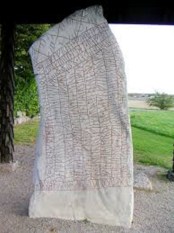 Have you ever utilized runes for divination? Did you ever ponder where these supernatural engravings originated from and how they wound up on minimal level stones utilized for fortune telling? Give us a chance to begin from the earliest starting point…
Have you ever utilized runes for divination? Did you ever ponder where these supernatural engravings originated from and how they wound up on minimal level stones utilized for fortune telling? Give us a chance to begin from the earliest starting point…
Runes are essentially letters in the runic alphabets and were used in Germanic languages from around 150 AD (mainly before the Latin alphabet was introduced). The Nordic countries have a long history and many surviving remnants of rune inscriptions, one being “The Rök Runestone” from my region in Sweden. I remember going for a day trip with school to see this stone, which contains the longest pre-Christian runic inscription that has been found, and is believed to be a piece of lost Norse Mythology.
There are many opinions on what runes were and how they were used, however, they are thought to have been used for communication originally and later also for magical purposes (such as victory inscriptions on swords). Before there was a runic alphabet there were of course stone carvings with various symbols that depicted the sun, fertility, hunting and so forth. Seeing that people back in those days were very much in tune with Mother Earth and their beliefs in various Nordic Gods, one would think that it was not long before the runes were incorporated in rituals of magic and prayer. Life back in the old north was filled with superstition, magical rituals and a strong fear of the Gods’ anger.

How did the runes end up on small stones used for scrying? Well, this is surprisingly a very young tradition. It was in fact originated by Ralph Blum in the 1980’s through his book “The Book of Runes: A Handbook for the Use of an Ancient Oracle” and was derived from the I Ching (!). To be honest, I was quite disappointed when I found out that scrying with runes is a modern development and not an ancient technique like the Tarot System. Perhaps it is just because runes are part of the very long history of my own country, but I never really considered that it could be a “new invention”.
Ralph Blum’s book was followed by many others on the subject and today divination with runes is commonplace. One can buy rune stone sets made out of crystals like amethyst, actual stones, wood or plastic. You could even make your own ones with a few flat pebbles and a marker (I did that as a teenager after reading about the symbols in a girls magazine!). Although there is no clear evidence that runes were in fact used in magical rituals and although I rarely use divination as such, I still enjoy these little magical symbols. There is a lot of history in the carvings themselves and in the myhtology they tell. Runes are a part of the history of my native Sweden that I hold close to my Nordic heart.


It is intriguing to learn that the modern usage of runes for divination is a relatively recent development. This highlights how ancient symbols can gain new meanings and applications in contemporary times.
The transition from runes being used for practical communication to their integration into magical rituals reflects a significant cultural shift. Understanding this evolution helps in appreciating the multifaceted nature of ancient societies.
The blend of historical fact and modern reinterpretation in the use of runes is a compelling example of how traditions are both preserved and transformed. This duality is a testament to the enduring appeal of ancient symbols.
The fact that modern rune divination can be traced back to Ralph Blum’s book in the 1980s underscores the continuous reinvention of cultural practices. This adaptation process is a common phenomenon in human history.
While it may be disappointing for some to learn that rune divination is a modern practice, it doesn’t diminish the historical value of runes themselves. Their significance in history remains substantial.
The historical origins of runes and their use in communication and rituals offer a remarkably rich cultural heritage. It’s fascinating to see how perceptions and uses can evolve over time.